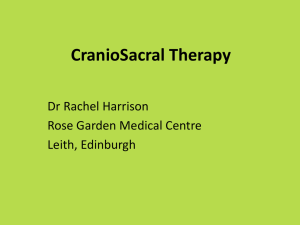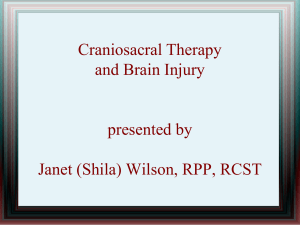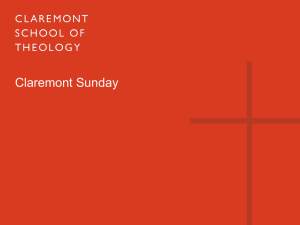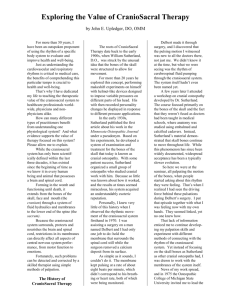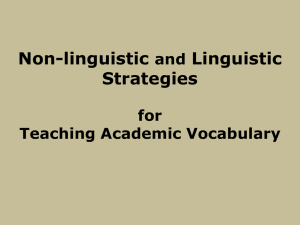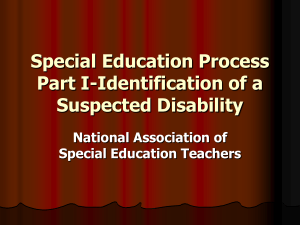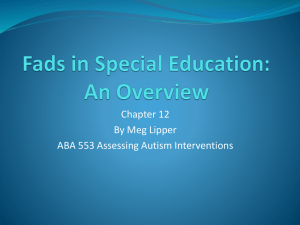here - Nancy Burke, CST
advertisement
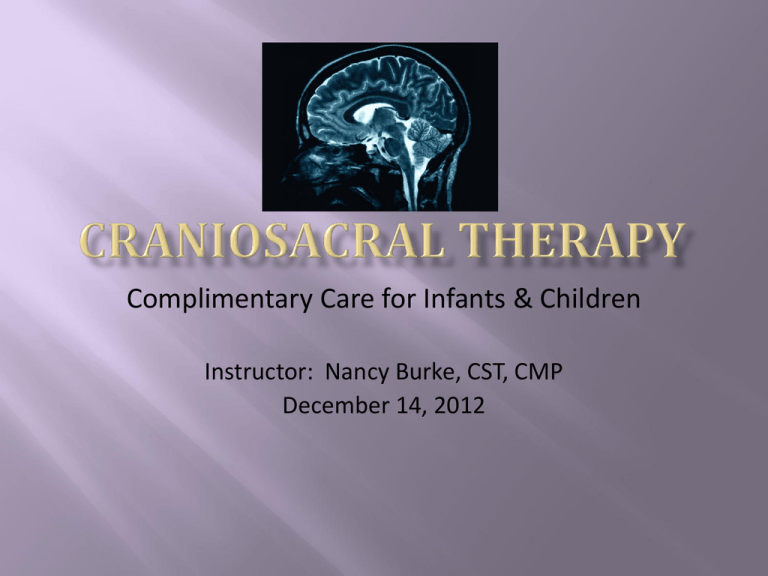
Complimentary Care for Infants & Children Instructor: Nancy Burke, CST, CMP December 14, 2012 Participants will gain an appreciation for the role of Craniosacral Therapy (CST) in the treatment of infants & children Participants will attain a general understanding of Craniosacral Therapy (CST) as it relates to the cerebral spinal system Participants will be able to recognize 5 conditions where CST would be an effective complimentary treatment with infants & children Participants will be able to communicate to caregivers the benefits of CST for infants & children 2 History of Craniosacral Therapy (CST) • How CST was developed • How CST works My Journey • My personal story • How CST works for me • How I found Craniosacral Therapy • My training 3 How CST works for Infants & Children • Issues and Treatment • Ages 0 - 2 • Age 3 – 7 • Ages 8 - Adolescent Case Studies Reasons to Refer to Craniosacral Therapy 4 How CST was developed: • The Craniosacral System is a recently discovered physiological system. • William Sutherland, D.O. began investigation in this field in the second decade of the twentieth century. • At the College of Osteopathic Medicine at Michigan State University in the early 1970’s a team of researchers began work under the premise that cranial bones move. 5 • Researchers studied fresh cranial bone specimens, through the use of optical and electron microscopy showing the existence of blood vessels, nerve fibers, collagen and elastic fibers within cranial sutures. • The mechanisms behind cranial motion were studied– focusing on the role of the dura mater and the cerebrospinal fluid. • The results from their research influenced the therapeutic application of cranial techniques. • Dr. John Upledger was the primary developer of techniques for evaluation and treatment. 6 How CST works: • The use of palpation is key to craniosacral therapy. • Structures beneath the skin—their form, movement and relationship to each other—are explored through palpation. • The craniosacral system possesses its own physiological activity with all the characteristics of a semi-closed hydraulic system formed by the dura mater membrane and its contents. • Membranes are given shape by the fluid pressure in the system and the more rigid structures such as the cranial bones and the spine. 7 Human Dural Membrane 8 • In CST, bones in the cranium and the spine are used as “handles” to release the restrictions in the membrane system to allow the fluid to flow properly. • Functionally, the cranial system is related to the central nervous system, the autonomic nervous system, the neuromusculoskeletal system and the endocrine system. • The system’s fluid intake is via the choroid plexus which allows passage of fluid from the vascular system into the ventricular system of the brain. 9 ANTERIOR Sacrococcygeal complex Sagittal suture Foramen magnum SUPERIOR INFERIOR POSTERIOR Anterior-Posterior and Superior-Inferior Axes of the Dural Membrane System 10 • The dural system is continuous down the spine to the coccyx. • The dural sleeves extend off what is known as the dural tube. • Attached to those sleeves is the connective tissue that then runs throughout the body with many attachments to bone, muscle, viscera– including the cranium, brain, coccyx, dural sleeves, etc. • This allows the therapist to access the cranial system from any area of the body. 11 Sacrum Occiput Dural Tube Continuity 12 Sutures Dural membrane Skull bones Cerebrospinal fluid Dural membrane (spinal region) Semi-Closed Hydraulic System of the Cerebrospinal Fluid and Dural Membrane 13 My personal story • History of 2 car accidents as a young adult and a bike accident as an adolescent. • Experienced ongoing issues with my neck and chronic headaches for years. • Cranial work helped me heal from the neck pain and the headaches virtually went away. 14 How I found Craniosacral Therapy • • • Introduced to Craniosacral Therapy while working in a chiropractic office. The chiropractor provided CST as a modality in her practice and I received CST as a patient. I found the work so beneficial and interesting that I began to study cranial work—that was about 21 years ago. 15 How CST works for me • CST is both relaxing and structurally precise. • Assists the body in finding its own innate balance on both a physical and an emotional level. • Cranial work moves through many levels, surface to deep via the brain, dura, and the spinal cord. • The focus and depth of the work enables me to work on the layers of physical issues. 16 My training Advanced training at the Upledger Institute over many years. • Most recently, advanced training specifically in pediatric CST with French osteopath Dr. Alain Gehin. • Coursework, seminars, and consultation in Pediatric CST with Benjamin Shield, PhD. • 17 Osteopathic perspective: We work with babies because when we look at a child, we never know what or who they can be. And when we look at an adult, we never know what or who they could have been. 18 Newborns, infants and children present special craniosacral system problems. Craniosacral Therapy with infants and children: • Utilizes simple and effective techniques to assist in normalizing the structure o balance the nervous system o resolve possible birth experience related issues. o 19 Delivery of posterior shoulder. Harry Oxorn, Human Labor & Birth (Norwalk: Appleton & Lange, 1986) 20 CST works to aid in the prevention of numerous • developmental • sensory • learning • structural • emotional problems. 21 Under normal conditions, the skull of the term fetus is truly a membranous sac filled with cerebrospinal fluid. • This fluid contributes an internal pressure to this semi-closed system. • The bony developments in the fetal and infant skull may be thought of as “hard places” in the membrane—contributing to its shape and functional integrity. 22 • As maturation occurs, the distances between these bony hard places are reduced. o The ratio of flexible membranous cranial vault to more rigid osseous cranial vault changes in favor of the latter. • As the newly delivered child develops, the character of the cartilage, membrane and bone which comprise the cranial vault undergoes considerable modification. 23 24 Adult and Fetal Skulls 25 The newborn skull is extremely flexible. Therefore, the techniques for examination and treatment of the newborn craniosacral system are quite different from those applied to the adult. As the person develops from newborn to adult, the techniques of craniosacral examination and treatment must be gradually modified. 26 THE OCCIPITAL BONE AT BIRTH occipital squamous portion - felt at the back of the head areas of growth cartilage - this allows for distortion between bony segments during birth In a newborn the occipital bone, found at the base of the skull, is in four parts, which functionally act as separate bones that are capable of moving in relation to each other at the time of birth. condylar parts - form joints with the first neck vertebra foramen magnum - space for spinal cord to exit cranium basal part (cannot be seen as inside skull) 27 Craniosacral system motion in the newborn and infant is more difficult to perceive than in the adult. The range and amplitude of motion are much less in the newborn. The inherent energy which drives the system also seems much less than in the adult. Moreover the levers (cranial vault bones) are significantly smaller and the movement of the membranous regions more subtle. 28 DISTORTION OF THE OCCIPITAL BONE Distortion of the four parts of the occipital bone as a result of birth trauma Occipital squamous portion has twisted and compressed on to the condylar parts area of compression or distortion area of distortion and compression on to 1st neck vertebra distortion of the space of foramen magnum Tajinder K.Deoora, Healing through Cranial Osteopathy (London: Francis Lincoln Ltd., 2003) 29 Common intraosseous distortions of the occiput Franklin Sills, Craniosacral Biodynamics (Berkley: North Atlantic Books, 2004) 30 I believe that every newborn can benefit from an initial cranial session upon birth. ~ Nancy Burke, CST 31 CST is an extremely gentle process well suited for children’s sensitive systems. For children, cranial work is an excellent compliment to western medicine. CST can compliment treatment of many childhood physical issues. 32 Compression of the occipital condyles: • A common problem found in preschool and grade school children. Can be responsible for o hyperkinetic behavior o abnormal fears o inability to concentrate. The temporal and occipitomastoid sutures: Can be dysfunctional in children who have dyslexia. 33 Ages 0 – 2 Issues and Therapeutic Protocols • There are a number of issues CST can address in this age group including: o o o o o o o o o o Colic Breast Feeding Problems Birth Trauma Birth Induction Reflux C-Section Digestive Issues Recovery from Falls Immune Boosting, especially Post-Immunization Forceps & Vacuum-assisted Deliveries 34 Discomfort for babies often presents in the digestive system. Digestive systems are still evolving in babies younger than 4 months old. Natural for digestive distress (also known as colic) to develop when the causative factor for the distress has not been resolved. 35 36 Often work on the mother is done alongside the infant . • Physical and emotional well being is known to be connected between mother and infant. A typical session may include work to the pelvis and sacral area, visceral work to the digestive system, and cranial work. 37 Ages 3 – 7 Issues and Therapeutic Interventions • Ear infections, speech issues, immune boosting, and asthma are some of the issues addressed in this age group. • Specific protocols are used for both asthma and ear infections. o Asthma: Includes structural work, visceral techniques, acupressure, and cranial work. o Ear infections: Structural work to encourage drainage, work on the cranium and the ears. 38 39 Ages 8 – Adolescent Issues and Therapeutic Applications • Orthodontics, sports injuries, car accident traumas, anxiety, depression are some of the issues of this age group. • The bone structure in the cranium has finished most of its growth by this age. • After age seven children can be worked with just like adults. 40 Orthodontic treatment: • Headaches and jaw issues can develop. • A cranial session after each adjustment is recommended to avoid any adverse reactions to the dental work. • Focus of CST is to bring the cranial system into balance and work specifically on the cranium. o with dental work the bones of the cranium can develop fixations and restriction patterns. 41 Jane E. Carreiro, An Osteopathic Approach to Children (London: Churchill Livingstone, 2003) Schematic arrangement of occiput and sphenoid into the sphenobasilar synchondrosis (SBS) strains described by William Sutherland (A) A right-side bending rotation pattern. (B) A right-torsion pattern. (C) A lateral strain, (D) A superior vertical strain. 42 Anxiety and Depression: • Can have physiological roots. • CST can address the physiological imbalances that may be present. o For example, a compression in the L-5-S-1 area, the atlas occipital juncture, or the sphenoid can contribute to physiological depression. 43 44 Name: Mary Age: 9 months Gender: Female Race/Ethnicity: African-American, Yugoslavian, Puerto Rican, Caucasian, Filipino Adopted; adoptive parents Caucasian Presenting Problem(s): severe reflux, torticollis on the left side, increased muscle tonus in both her arms and legs, and low tonus in her trunk. Vision impairment, hypoxia, globally dispersed damage, coordination issues and sensory issues, plagiocephaly, and seizures. 45 Name: Elise Age: 6 weeks Gender: Female Race/Ethnicity: Caucasian Presenting Problem(s): History of heart surgery; paralyzed vocal cord; suck, swallow & breath not coordinated; reflux; history of collapsed lung. 46 Name: Andrew Age: 10 weeks Gender: Male Race/Ethnicity: Caucasian; Czechoslovakian Presenting Problem(s): Breast feeding difficulties; disorganized suck; tongue-tie; muscle tension; fussy; little to no eye contact. 47 Symptoms experienced by babies and young people where CST may be an appropriate referral are: • • • • • • • • • • • Babies who are “uncomfortable” in their bodies Babies who are crying a lot Sleep difficulties Eating issues Ear infections Sinus and Breathing Problems Gastrointestinal Disturbances Birth Trauma Headaches Torticollis Learning difficulties 48 CST can be a wonderful compliment to western medical treatment, helping clients regain their health and well being. 49 Gehin, D.O., Alain. (2011). Pediatric Seminar. Berkeley, CA. Shield, Benjamin, PhD. (2007). Pediatric Craniosacral Therapy: Newborn through Age Two. Berkeley, CA. Upledger, D.O., F.A.A.O., John E. (1987). Craniosacral Therapy 1 Study Guide. UI Publishing, Florida. Upledger, D.O., F.A.A.O., John E. & Vredevoogd, M.F.A., Jon D. (1983). Craniosacral Therapy. Eastland Press, Seattle. Upledger Institute & Clinic, Palm Beach, Florida. 50
